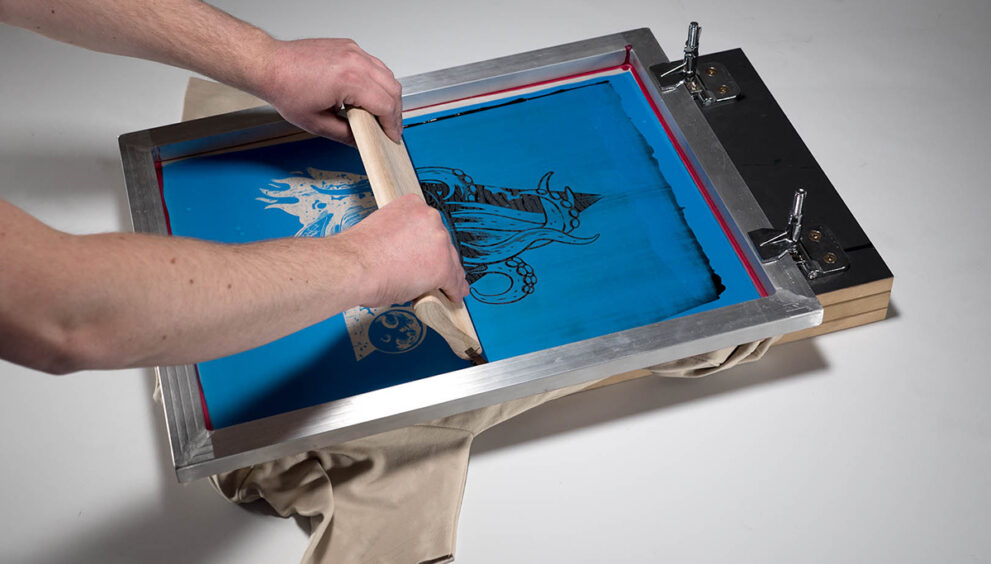Custom Silk Screen Printing on T-Shirts

Custom silk screen printing on t-shirts is a timeless method of apparel decoration that has been cherished for its versatility, durability, and ability to produce vibrant designs. With its roots tracing back to ancient China, silk screen printing one of the t shirt printing methods has evolved into a sophisticated process that allows for the creation of intricate and eye-catching designs on t-shirts of all kinds. In this comprehensive guide, Dallas T-Shirt printing store explore the fascinating process of custom silk screen printing on t-shirts, from design preparation to the final product, and delve into the techniques, materials, and creative possibilities involved.
Understanding Silk Screen Printing
Silk screen printing, also known as screen printing or serigraphy, is a printing technique that involves transferring ink through a mesh screen onto a substrate, such as fabric, paper, or plastic. The process utilizes a stencil, known as a screen, which is created using a fine mesh material, typically silk (hence the name), polyester, or nylon. Each color in the design requires a separate screen, allowing for precise registration and vibrant multi-color prints.
The Process of Custom Silk Screen Printing
Custom silk screen printing on t-shirts is a multi-step process that requires precision, attention to detail, and specialized equipment. Here’s a detailed overview of the process:
- Design Creation: The silk screen printing process begins with the creation of the design to be printed on the t-shirt. Designs can be created using graphic design software or hand-drawn and then scanned into a digital format. It’s essential to ensure that the design is suitable for silk screen printing, with distinct colors and clear lines.
- Screen Preparation: After the design is complete, the screens are ready to be printed. Screens are coated with a light-sensitive emulsion and then exposed to UV light through a film positive of the design. The UV light hardens the emulsion, creating a stencil of the design on the screen. The unexposed areas of the emulsion are then washed away, leaving behind the stencil.
- Ink Mixing: The next step is to mix the ink colors needed for the design. Silk screen printing inks come in a variety of colors and formulations, including plastisol, water-based, and discharge inks. The ink is mixed to the desired color and consistency, ensuring proper adhesion and vibrancy on the t-shirt.
- Screen Printing Setup: With the screens prepared and the ink mixed, the printing press is set up for printing. The t-shirt is placed onto a platen, and the screen with the first color of the design is positioned above it. The screen is then flooded with ink, and a squeegee is used to pull the ink across the screen, forcing it through the stencil and onto the t-shirt below.
- Printing Process: Once the first color is printed, the t-shirt is moved to a drying station to cure the ink. The process is repeated for each color in the design, with a separate screen and printing pass for each color. Each color is carefully registered to ensure precise alignment and overlap, resulting in a vibrant and cohesive design.
- Curing the Ink: After all colors are printed, the t-shirt undergoes a curing process to ensure proper adhesion and durability of the ink. This typically involves passing the t-shirt through a conveyor dryer or using a heat press to apply heat and pressure to the printed area, curing the ink and bonding it to the fabric of the t-shirt.
- Quality Control and Finishing: Once the ink is cured, the t-shirt undergoes a thorough quality control process to ensure that the print is crisp, clean, and free of defects. Any imperfections are corrected, and the t-shirt may undergo finishing touches such as trimming excess threads before being packaged and shipped to the customer.
Creative Possibilities of Silk Screen Printing
Silk screen printing offers endless creative possibilities for customizing t-shirts with vibrant designs, bold graphics, and intricate details. Some of the key advantages and creative applications of silk screen printing include:
- Vibrant Colors: Silk screen printing allows for the use of vibrant, opaque inks that create bold and eye-catching designs on t-shirts.
- Multi-Color Prints: Silk screen printing is ideal for multi-color designs, with each color printed separately to create intricate and layered effects.
- Durability: Silk screen printing produces durable prints that withstand repeated washing and wear, making it suitable for both everyday wear and promotional use.
- Customization: Silk screen printing allows for customization of t-shirts with logos, graphics, text, and other design elements, making it a popular choice for businesses, organizations, and events.
Materials and Techniques
Silk screen printing on t-shirts can be done using a variety of materials and techniques to achieve different effects and styles. Some common materials and techniques include:
- Screen Mesh: Screens come in a variety of mesh counts, which affect the level of detail and resolution in the printed design. Finer mesh counts are used for detailed designs, while coarser mesh counts are used for bold, opaque prints.
- Ink Types: Silk screen printing inks come in a variety of formulations, including plastisol, water-based, and discharge inks. Each type of ink offers its own unique properties and advantages, allowing for versatility and creativity in the printing process.
- Printing Presses: Silk screen printing can be done using manual, semi-automatic, or automatic printing presses, depending on the volume and complexity of the printing job. Manual presses are suitable for small runs and manual registration, while automatic presses offer higher production speeds and precision registration.
Advantages of Silk Screen Printing
Silk screen printing offers several advantages over other printing methods, including:
- Vibrant Colors: Silk screen printing produces vibrant, opaque prints with excellent color saturation and vibrancy.
- Durability: Silk screen printing produces durable prints that withstand repeated washing and wear, making it suitable for both everyday wear and promotional use.
- Versatility: Silk screen printing can be used to print on a wide range of fabrics, including cotton, polyester, and blends, making it a versatile option for customizing t-shirts and other apparel items.
- Cost-Effectiveness: Silk screen printing is cost-effective for large production runs, with lower per-unit costs compared to other printing methods for high-volume orders.
Conclusion
Silk screen printing on t-shirts is a versatile and time-tested method of apparel decoration that offers endless creative possibilities for designers, businesses, and individuals alike. By understanding the intricate process of silk screen printing, selecting the right materials and techniques, and unleashing their creativity, designers and enthusiasts can create unique and memorable t-shirts that make a lasting impression. With its vibrant colors, durability, and versatility, silk screen printing remains a popular choice for customizing t-shirts and expressing creativity through apparel decoration. Whether used for branding, promotion, fashion, or personal expression, silk screen printing offers a timeless and sophisticated way to elevate t-shirt designs and make a statement in the world of fashion and apparel.


 English
English 


